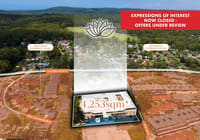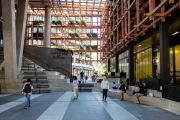
Landlocked, this wood-clad home has edgy views over Sydney Harbour
On a landlocked site, a stone’s throw from the beach in Sydney’s exclusive Vaucluse, sits a wood-clad home with edgy views over the harbour.
Shiplap House is the brainchild of Chenchow Little Architects, an architecture practice that rarely, if at all, repeats a design. Each new house has its own voice and beautifully captures the essence of its location.

In the case of Shiplap, the design responds to past and present. The home’s plot, sliced off an adjoining house, is essentially landlocked. Only a narrow laneway accesses the property.
“One of our starting points was the heritage timber Victorian cottages that surround us, as much as the view of Sydney Harbour,” says architect Tony Chenchow, who worked closely with his life and business partner, architect Stephanie Little.
While there wasn’t an opportunity to create one heroic picture window to the harbour, the battleaxe block of about 500 square metres did allow for a diamond-shaped home, with multiple windows that offer unimpeded sight lines through the surrounding timber dwellings. As a result, there are few, if any, right-angled lines in the home. Each space benefits from a different orientation and aspect.
Reflecting the surrounding timber cottages, Chenchow Little Architects opted for shiplap timber cladding with large picture windows edged in steel and slightly angled. “Even though the angle is approximately 5 degrees, you see some of Sydney’s landmarks, such as the Harbour Bridge, rather than your own reflection,” says Chenchow.
As with Victorian timber fences, the external cladding also features a pointed edge across all three floors of the house. “We didn’t want to mimic the past but respond to the context while also creating a contemporary home for a couple with three young children,” adds Chenchow, pointing out the vertical timber battens, with their filagree edges, as a contrast to the Victorian cottages, which have a horizontal arrangement.
Accessed via a native garden, designed by landscape architect Sue Barnsley, the front door, with its protective steel awning, is not much more than a slot in the wall. It’s only when passing the threshold that one’s eyes really go into overdrive, with a curvaceous concrete staircase linking the home’s three levels.
As with a number of the architects’ designs, there is a distinctive thread of less is more. Apart from the timber floors in the bedrooms on the middle level, other floors are made of polished concrete, and slightly angled concrete walls extend from the floor, minimising overlooking of any neighbouring properties.
In the kitchen, dining and living areas, on the top level, there’s a sense of transparency but also loose delineation – an outdoor courtyard pierces the core of the house, as does the staircase. “Our clients previously lived in an open-plan house and they were tiring of it, keen to see their children, but also to have spaces that could be separate,” says Chenchow, who included a rumpus room at ground level.

Given the location and the fairly challenging weather conditions on the headland, Chenchow opted for an unusual treatment of the windows, with the large thermal glass windows being fixed and smaller apertures placed to one side, with operable timber shutters allowing for ventilation when required. “We saw these large windows like significant works of art, framing each specific view not dissimilar to a photograph,” says Chenchow.
And rather than overstuff the interiors with Victorian furniture, there are built-in leather lounges and oak veneer shelves to further declutter the spaces in this 250-square-metre home. Instead of including additional shelves for areas such as the children’s bedrooms, the 40-centimetre-wide sills double as display ledges for toys and books.
Shiplap House is certainly out of the box, completely different to Chenchow Little’s other designs. While some have compared this home to modernist houses found in the Hollywood Hills, such as those by the eminent architect John Lautner, this one has its own voice, making itself heard but not screaming for attention.











